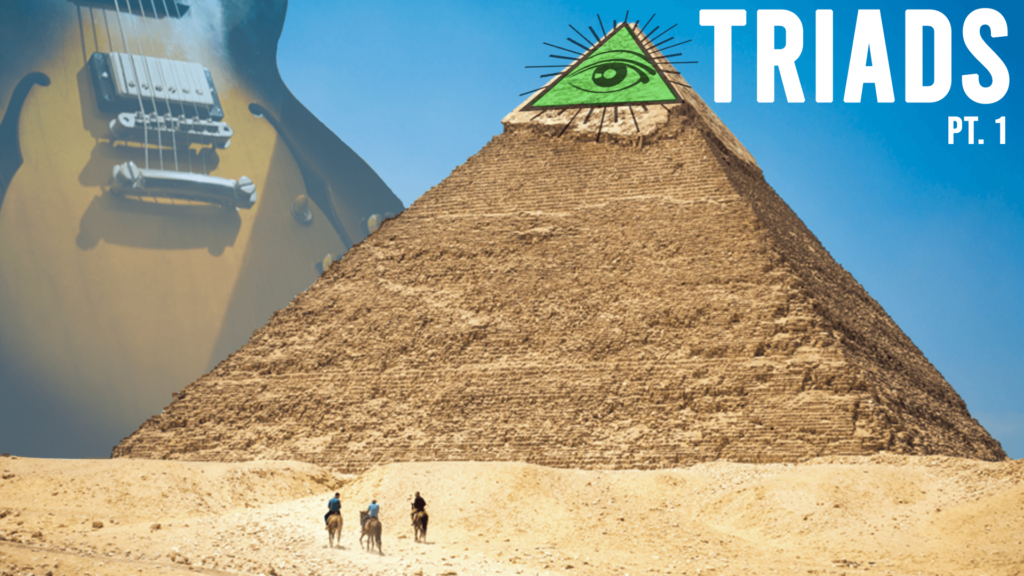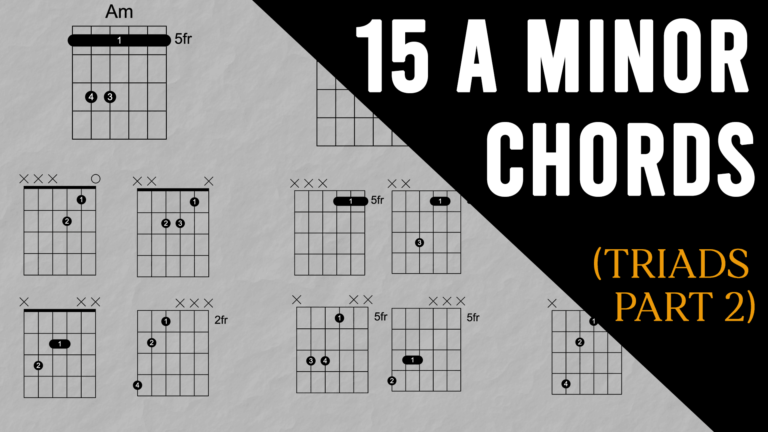Turn Your 3 C Chords Into 15

It’s a astounding to me how some guitar players can spend their whole lives stuck in the first 4 frets. There’s nothing wrong with the open position, it’s amazing…but where is the curiosity to find what else is out there?
In this lesson, I’ll show you 15 different ways to play the C major chord all over the fretboard. That might sound crazy, but you’ll be surprised at how achievable it is. And if you’ve been keeping up with these lessons, you already have 3 of those 15 under your belt. Winning!
The benefits of doing this are huge and you’ll thank me if you spend some time exploring this way of playing the guitar. We’ll talk about that more later, but for now let’s get into it.
TRIADS
C major, affectionately know as just ‘C’, is comprised of 3 different notes – C, E and G. This type of chord is called a major triad. Triads consist of 3 different notes. The most common triads are called – major, minor, diminished and augmented.
Forget those last 2 for a second. Let’s focus on the major and minor ones.
Any chord symbol that is just one letter (A, B, C, D, E, F or G), or one letter followed by a sharp (#) or flat (♭) symbol, refers to a major triad. For example: A♯, E♭, D♭, and so on.
Any chord symbol that looks the same as any of the major triad symbols above, but has a small ‘m’ after it, refers to a minor triad. For example: Am, C♯m, D♭m, F♯m, Gm, and so on.
THE 3 PARENT CHORDS
First we’re going to review the 3 parent chords that all of our triad babies come from. These parent chords are all C major triads:

You can learn more about the 1st one here, and the 2nd and 3rd chord (the barre chords) here.
If you have trouble playing the barre chords, don’t worry because you don’t have to play them clearly to play the other 12 coming up.
THE OPEN C CHORD
The open C chord uses 5 strings. I know what you’re thinking – But I thought a C chord only has 3 notes in it – C, E and G. Good memory, you are correct…but they are 3 different notes. Then how come you play 5 notes? Because some of the notes are doubled.
This open C chord has 2 C’s in it (5th string and 2nd string), 2 E’s in it (4th string and 1st string) and one G (3rd string).
We’re going to derive 4 C major triads from this open C chord. Each of these triads uses just 3 strings, so no doubled notes – just one C, one E and one G. Here they are below in Fig.2:

Fig.2 – 4 triads derived from the open position C chord
Make sure you only put the necessary fingers down for each one. Don’t just hold the open C chord and play the appropriate strings. You want to use the parent chord as an anchor, but think of each one as a seperate chord.
That means, for the first chord, place only one finger down. Then only 2 fingers for the 2nd and 3rd chords. For the last one, use the same fingering as you would for an open E chord.
Once you get comfortable with playing it from left to right, play it from right to left.
Pro tip: This is a good opportunity to work on your fingering. You can also play it with a pick, but why not try using your thumb, index and middle fingers to pluck each triad.
THE 5-STRING C BARRE CHORD
In this video, I talk about this chord in detail. I mention that I actually don’t usually barre with the first finger in this chord form. Normally, I do the 3rd finger barre on the 5th fret, but then just play one note (3rd fret, 5th string) with the first finger.
This is a tricky chord for those of you who are new to it. I’ll leave it up to you to work on it, for now let’s extract 4 more babies from this parent chord:

Moving from left to right as we did before, you can see in the first chord that your 3rd and 4th finger are on the 5th fret. As you move through each chord, you’ll notice that you start to move horizontally across the fretboard. So when you move to the 2nd chord, you will shift so that the 5th fret is played with a first finger barre.
In chord number 3, you keep the first finger where it is, then reach the 3rd finger over to that 7th fret. In the 4th chord, you can abandon the barre, only playing one note with that first finger and stretching that 4th finger onto the 8th fret of the 6th string.
This set is harder than the open set, so take your time before moving on. Work on each chord change as if you were choreographing some sort of fretboard dance. It’s a bit of a workout for the left hand.
Do the sequence from right to left as well.
THE 6-STRING C BARRE CHORD
Finally, we will now derive 4 chords from the 6th string C barre chord. Again, you will find more detail about these barre chords here.

Going from left to right, you can see that you need to barre 2 strings in the first chord. The 2nd one is straightforward, the 3rd one is like that E shape again, and the final shape is like chord number 3 of the previous set.
By now you understanding the process, so just practise it left to right, then right to left and make sure everything rings clearly. I will mention one more time that these 3 note chords are a great opportunity to practise your fingerpicking.
WHAT’s NEXT??
There are many directions that you could go in from here to expand on what we’ve learned. Here is one suggestion:
Instead of practising these triads within each parent chord area, why not mix them up. The best way to start with this is to move through the ones on the same string set, ie. Play chord number 1 in Fig.2, then chord 1 in Fig.3, then chord 1 in Fig.4.
You could then do that for every string set.
FINAL THOUGHTS
I could keep going with expanding this concept, but we’ve done enough for this lesson. I hope this lesson was helpful and that you can see how memorising these 15 chords in this manner is not that hard. There are a few physical challenges in there, sure…but this system of using parent chords as anchors to locate other chords streamlines the process of learning so many chords.

